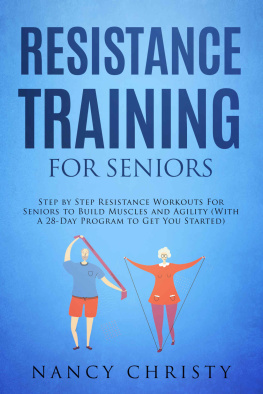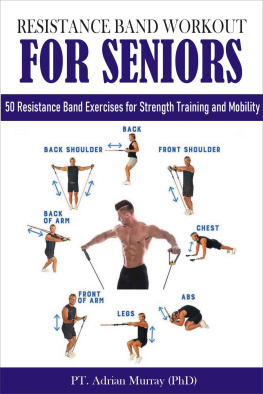O nce reserved solely for rehabilitation settings, rubber tubing has become a staple in fitness and sport performance training. Rubber tubing will allow you to increase muscle strength, power, and speed, helping you to alter your appearance by aiding fat loss and changing the appearance of your muscles.
The benefits of strength training with rubber tubing goes far beyond the performance and appearance changes many people initially seek when they start their training.
Preventing Injuries
Whether you are playing a sport or walking on an icy street, injuries can occur at any time. Stronger bones, muscles, joints, and connective tissue will make you more resistant to the acute injuries that occur during falls or collisions with an opponent, but the real benefits of strength training come in the prevention of the chronic shoulder, knee, and back pains that can make everyday life more difficult.
Muscle imbalances, either bilateral differences between the right and left sides of the body, or agonist/antagonist imbalances in muscles that are on opposite sides of a joint, have been implicated in the development of injury. Muscle imbalances cause the body to move incorrectly, resulting in excessive strain on some muscles and joints. Some studies have noted that a muscle imbalance of greater than ten percent between the right and left sides of the body increase the risk of injury twenty times.
Most sports, and many of our daily activities, force us into a position where one side of the body is used more than the other, leading to muscle imbalances. Tubing is particularly effective at preventing injuries because most of the exercises are unilateral, meaning that the right and left sides work independently, forcing each side to contribute the same amount work to each exercise.
The Anti-Aging Formula
There is a relationship between muscle size and strength. This does not mean that you need to develop huge muscles to become strongeven small increases in muscle size will dramatically increase strength. As we age, there is a decline in muscle mass and strength, leading to chronic aches and pains, difficulty performing daily activities, and a loss of independence and quality of life. This deterioration in performance can start as early as age thirty and gets worse every year, but dont despair; a moderately intense full body strength training program with resistance bands, performed two or three times per week, can delay and even reverse the loss of muscle mass.
Its never too late to start a strength-training program. Muscle mass and strength can increase in people well into their 70s. There are many retired people who are physically stronger and more fit after taking up resistance-band strength training than they were in their youth.
Strength training is a life-long physical activity that also carries with it a variety of health benefits, including improved blood lipid profiles and increased bone density.
ALTERED BLOOD LIPID PROFILES
High blood-cholesterol levels have been associated with the development of heart disease. Controlling cholesterol levelsincreasing HDL (the good cholesterol) or decreasing LDL (the bad cholesterol)can lessen the incidence of heart disease. Strength training has been shown to decrease total cholesterol and improve the LDL/HDL ratio that is strongly linked to health problems by decreasing LDL and increasing HDL levels.
INCREASED BONE DENSITY
Osteoporosis is a widespread problem in modern society, particularly among older people. After age thirty-five, bone density starts to decline at a rate of one to three percent per year. While this may not sound like much, the cumulative effect of years of bone loss can result in bone fractures and overall frailty in old age. We have known for more than a century that there is a relationship between mechanical loading of bone and bone density and strength. Certain types and volumes of physical activity increase bone mineral density (BMD) while immobilization, lack of weight-bearing activity, and prolonged bed rest decrease bone density. Resistance-band strength training, taken up after age thirty-five, is one of the best ways to slow or halt the normal loss of bone density. Taking strength training up earlier in life may provide even more benefits. Strength training during your teens and early twenties can increase bone density, providing you with a buffer against future bone loss. Even if there is a period in your life when you are unable to exercise to maintain your bone density, you have some to spare.
Strength Training for Children
The use of strength training for children has gained acceptance as part of a well-rounded fitness program. The risks of injury to children during strength training are lower than those of most other popular participation sports and the notion that resistance training will damage growth plates in the bones has not been born out by research. A well designed resistance-band strength program that focuses on the individual physical and psychological maturity level of the child can not only decrease the risk of injury in other sports but it can improve bone density, positively alter body composition and increase the childs self esteem. An early, positive strength training experience can foster a lifelong appreciation for physical activity.
Based on the NSCAs position statement and reviews by the American Academy of Pediatrics, the following guidelines are recommended for developing strength training programs for prepubescent children:
- Young athletes require a medical examination prior to strength training, including assessing their physical maturity level.
- There is no lower limit on age when a child can start strength training. Decisions on starting age should be based more on emotional maturity and the childs ability to follow directions than on physical development.
- Provide adequate supervision and instruction. The athlete-coach ratio should not exceed 10:1 with a ratio of 5:1 preferred. This should help the athlete learn proper technique. Most strength training injuries occur because of poor exercise technique.
- Prohibit maximal lifts.
- Ensure that the athlete is emotionally mature to accept and follow directions. Athletes risk injuring themselves and others when strength training if they cannot follow directions and safety guidelines.
- Consider the unique physical and psychological make up of each athlete. Since the rate of emotional and physical maturity varies from person to person an individualized training program will help improve performance and decrease the chance of injury.
- Include strength training in a conditioning program. Expose young athletes to a variety of activities and movement patterns. Limiting training to a specific activity can slow the athletes overall development.
- Keep training fun for the athlete. By keeping training fun, the athlete can develop a lifelong appreciation of fitness and sport. The length of the athletes career can be increased if the level of enjoyment is high.
- Develop or adopt a set of weight-training rules and regulations.
Starting children into a strength-training program at an early age may help them develop the skills and attitudes needed to make strength training part of a life long commitment to exercise. Rubber tubing provides an inexpensive initiation to strength training, affording children a safe way to learn the basic body positions and movements before they go on to handle the heavier weights needed in some sports training programs.
Adequate supervision will ensure that the risks of injury often attributed to strength training are minimized, while the benefits, which include increased strength, improved blood lipid profile, enhanced motor skills, and decreased rate of injury in other sports, are maximized in an enjoyable setting.









